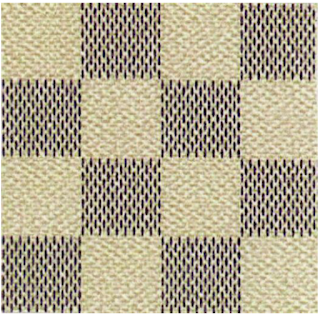Louis Vuitton received a favorable decision from the EU General Court (“General Court”) in June 2020 which may assist brand owners seeking IP protection of their decorative patterns. The decision confirms the distinctive character an EU trade mark must possess in order to benefit from protection throughout the EU as well as highlighting how patterns may be protected through registration as a trade mark rather than under other forms of IP protection such as copyright or design protection. However, the decision also reaffirmed the EU’s strict approach to assessing the unitary character of EU trade marks, which potentially sets a high bar for applicants to clear.
Background
In 2008, Louis Vuitton had obtained EU trade mark protection for the mark displayed below, the Damier Azur mark, in relation to class 18 goods including luggage, bags and leather goods. In 2015 a Polish individual, Norbert Wisniewski, challenged the validity of the mark by filing an application for invalidity with the EUIPO.

In 2016 the Cancellation Division of the EUIPO declared Louis Vuitton’s trade mark invalid under Article 59(1)(a) of the EU Trade Mark Regulation (“EUTMR”) on the grounds that the mark was devoid of any distinctive character in line with Article 7(b) of the EUTMR. The Cancellation Division did not agree with Louis Vuitton’s claim that the mark had acquired distinctiveness through its use. Louis Vuitton then took its claim to the EUIPO Second Board of Appeal who also dismissed their claim and agreed with the Cancellation Division.
General Court
In 2019 the matter was appealed to the General Court of the CJEU and Louis Vuitton put forward two main arguments that:
- the Second Board of Appeal had incorrectly assessed the inherent distinctive character of the Damier Azur mark as the Board had relied on ‘well-known facts’ to supplement the arguments presented by Mr Wisniewksi in the absence of any concrete and substantial evidence for a declaration of invalidity; and
- the Board of Appeal had failed to carry out an overall assessment of the Damier Azur mark and had therefore erred in its assessment of the distinctive character acquired through use of the mark.
With regard to point one, the General Court considered that the Board of Appeal had relied upon a number of well-known facts in its decision including how the chequerboard pattern of the mark was a commonplace figurative pattern, which is permissible. The General Court determined that the Board had been correct in its finding that the mark was a basic and a commonplace pattern that did not depart significantly from the norms of the sector and that this was a well-known fact within the meaning of case law. The first argument was therefore rejected.
As to argument two, the General Court inferred that the Board of Appeal had focused on evidence which expressly referred to a specific set of Member States and had excluded other evidence without conducting any further analysis on said evidence. The General Court determined that the excluded evidence did contribute to the arguments put forward by Louis Vuitton concerning the acquired distinctiveness of the mark including the widespread use of the mark across the whole of the EU and the market shares held by the mark in each Member State. The General Court thus found that the Board of Appeal had failed to sufficiently take into account the distinctive character of the mark in relation to the goods and services for which it is registered.
Takeaway points
The decision by the General Court reaffirms the wide scope of evidence and rigorous determination that must be followed by the courts and IP administrative bodies. The General Court also emphasized the need for a mark to be distinctive throughout the whole of the EU rather than just across a defined set of Member States, which is often a high threshold for applicants to meet (as seen in the Kit Kat case, among others). Although the General Court did annul the decision of the Second Board of Appeal on the basis of an error in the full assessment of the evidence, it is still not yet fully clear whether Louis Vuitton’s excluded evidence would be sufficient to prove the required distinctiveness of the mark as the General Court made no comment on this point. This is an intriguing space to follow and we will keep you updated as the case progresses.





 />i
/>i
